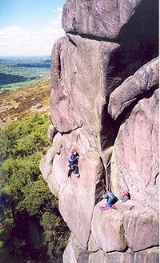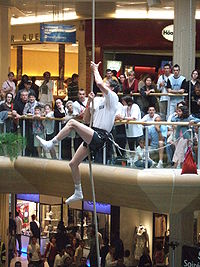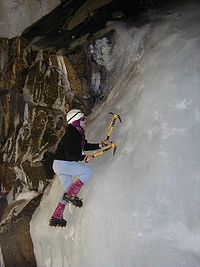
Climbing
Encyclopedia
.jpg)


Climbing activities include:
- BoulderingBoulderingBouldering is a style of rock climbing undertaken without a rope and normally limited to very short climbs over a crash pad so that a fall will not result in serious injury. It is typically practiced on large natural boulders or artificial boulders in gyms and outdoor urban areas...
: Ascending boulders or small outcrops, often with climbing shoes and a chalk bag or bucket. Usually, instead of using a safety rope from above, injury is avoided using a crash padBouldering matA bouldering mat or crash pad is a foam pad used for protection when bouldering. There are various sizes and makes, but the most common type is a folded mattress, 8 to 10 centimetres thick , that when unfolded measures about 1 x 1.3 metres . Bouldering mats often have shoulder straps so as to...
and a human spotter (to direct a falling climber on to the pad). - BuilderingBuilderingBuildering is the act of climbing on the outside of buildings and other artificial structures. The word "buildering" is a portmanteau, combining the word "building" with the climbing term "bouldering".If done without ropes or protection far off the ground, buildering may be dangerous...
: Climbing urban structures - usually without equipment - avoiding normal means of ascent, like stairsStairwayStairway, staircase, stairwell, flight of stairs, or simply stairs are names for a construction designed to bridge a large vertical distance by dividing it into smaller vertical distances, called steps...
, escalators, and elevatorElevatorAn elevator is a type of vertical transport equipment that efficiently moves people or goods between floors of a building, vessel or other structures...
s. Aspects of buildering can be seen in the art of movement known as ParkourParkourParkour is a method of movement focused on moving around obstacles with speed and efficiency. Originally developed in France, the main purpose of the discipline is to teach participants how to move through their environment by vaulting, rolling, running, climbing and jumping...
. - CanyoningCanyoningCanyoning is traveling in canyons using a variety of techniques that may include other outdoor activities such as walking, scrambling, climbing, jumping, abseiling, and/or swimming....
: Climbing along canyons for sport or recreation. - ChalkChalkChalk is a soft, white, porous sedimentary rock, a form of limestone composed of the mineral calcite. Calcite is calcium carbonate or CaCO3. It forms under reasonably deep marine conditions from the gradual accumulation of minute calcite plates shed from micro-organisms called coccolithophores....
climbing: cliffs of chalk may (with difficulty) be climbed using some of the same techniques as ice climbing http://www.firstascent.co.uk/b_person8.html. - Competition ClimbingClimbing competitionA climbing competition is usually held indoors on purpose built climbing walls.There are three main types of climbing competition:* Difficulty: competitors climb the same route one after the other...
: A formal, competitive sport of recent origins, normally practiced on artificial walls that resemble natural rock formations. The International Federation of Sport Climbing (IFSCInternational Federation of Sport ClimbingThe International Federation of Sport Climbing is the international governing body for the sport of competitive climbing, which consists of the disciplines lead climbing, speed climbing, and bouldering...
) is the official organization governing competition climbing worldwide and is recognized by the IOC and GAISF and is a member of the International World Games Association (IWGA). Competition Climbing has three major disciplines: Lead, Bouldering and Speed. - Ice climbingIce climbingIce climbing, as the term indicates, is the activity of ascending inclined ice formations. Usually, ice climbing refers to roped and protected climbing of features such as icefalls, frozen waterfalls, and cliffs and rock slabs covered with ice refrozen from flows of water. For the purposes of...
: Ascending ice or hard snow formations using special equipment designed for the purpose, usually ice axeIce axeAn ice axe, is a multi-purpose ice and snow tool used by mountaineers both in the ascent and descent of routes which involve frozen conditions. It can be held and employed in a number of different ways, depending on the terrain encountered...
s and crampons. Techniques of protecting the climber are similar to those of rock climbing, although the protective devices themselves are different (ice screws, snow wedges). - Lead ClimbingLead climbingLead climbing is a climbing technique used to ascend a route. This technique is predominantly used in rock climbing and involves a lead climber attaching themselves to a length of dynamic climbing rope and ascending a route while periodically attaching protection to the face of the route and...
: a specific sub-category of climbing in which the climber uses quickdraws to clip onto permanment bolts in the rock, and thus clips the rope into each quickdraw as she or he climbs up. A quickdraw consists of two caribiners attached on each end of a piece of webbing. One caribiner holds the rope and the other caribiner clips into the fixed bolts in the rock or gym wall. Quickdraw caribiners come with a variety of features including straight gate, bent gate, and wire gate. The carabiners are quickdraws never lock. Quickdraws may be attached to the gear loops on the waist of one's harness while climbing. - Mountain climbingMountaineeringMountaineering or mountain climbing is the sport, hobby or profession of hiking, skiing, and climbing mountains. While mountaineering began as attempts to reach the highest point of unclimbed mountains it has branched into specialisations that address different aspects of the mountain and consists...
(Mountaineering): Ascending mountains for sport or recreation. It often involves rock and/or ice climbing. - Net climbing: Climbing net structures. The climbing structures consist of multiple interconnected steel reinforced ropes attached to the ground and steel poles. Climbing nets are usually installed on playgrounds to assist children in developing their balancing and climbing skills.
- Pole climbing (gymnastic)Pole climbing (gymnastic)Pole climbing may be defined as ascending a pole which one can grip with the hands. The related activity of Mast climbing describes ascending an object similar to a pole, but having a larger diameter which excludes gripping with the hands...
: Climbing poles and masts without equipment. - LumberjackLumberjackA lumberjack is a worker in the logging industry who performs the initial harvesting and transport of trees for ultimate processing into forest products. The term usually refers to a bygone era when hand tools were used in harvesting trees principally from virgin forest...
tree-trimming and competitive tree-trunk or pole climbing for speed using spikes and belts. - Rock climbingRock climbingRock climbing also lightly called 'The Gravity Game', is a sport in which participants climb up, down or across natural rock formations or artificial rock walls. The goal is to reach the summit of a formation or the endpoint of a pre-defined route without falling...
: Ascending rock formations, often using climbing shoes and a chalk bag. Equipment such as ropes, bolts, nuts, hexes and camming devices are normally employed, either as a safeguard or for artificial aid. - Rope accessRope accessRope access is a form of work positioning, initially developed from techniques used in climbing and caving, which applies practical ropework to allow workers to access difficult-to-reach locations without the use of scaffolding, cradles or mobile elevated work platforms MEWPs...
: Industrial climbing, usually abseilingAbseilingAbseiling , rappelling in American English, is the controlled descent down a rock face using a rope; climbers use this technique when a cliff or slope is too steep and/or dangerous to descend without protection.- Slang terms :...
, as an alternative to scaffoldingScaffoldingScaffolding is a temporary structure used to support people and material in the construction or repair of buildings and other large structures. It is usually a modular system of metal pipes or tubes, although it can be from other materials...
for short works on exposed structures. - Rope climbingRope climbingRope climbing is a sport in which competitors, usually men, attempt to climb up a suspended vertical rope using only their hands. Rope climbing is practised regularly at the World Police and Fire Games, and is enjoying a resurgence in France, where competitions are held in shopping centres...
: Climbing a short, thick rope for speed. Not to be confused with roped climbing, as in rock or ice climbing. - ScramblingScramblingScrambling is a method of ascending rocky faces and ridges. It is an ambiguous term that lies somewhere between hillwalking and rock climbing. It is often distinguished from hillwalking by defining a scramble as a route where hands must be used in the ascent...
which includes easy rock climbing, and is considered part of hillwalkingHillwalkingIn the British Isles, the terms hillwalking or fellwalking are commonly used to describe the recreational outdoor activity of walking on hills and mountains, often with the intention of visiting their summits...
. - Tree climbingTree climbingTree climbing is a recreational or functional activity consisting of ascending and moving around in the crown of trees.Use of a rope, helmet, and harness are the minimum requirements to ensure the safety of the climber. Other equipment can also be used depending on the experience and skill of the...
: Ascending trees without the intention of harming them, using ropes and other equipment. This is a less competitive activity than rock climbing.
Rock, ice and tree climbing all usually use ropes for safety or aid. Pole climbing and rope climbing were among the first exercises to be included in the origins of modern gymnastics in the late 18th century and early 19th century.
See also
- Fall factorFall factorIn climbing, using a dynamic rope, the fall factor f is the ratio of the height h a climber falls before the climber's rope begins to stretch and the rope length L available to absorb the energy of the fall....
- Arboreal locomotionArboreal locomotionArboreal locomotion is the locomotion of animals in trees. In every habitat in which trees are present, animals have evolved to move in them. Some animals may only scale trees occasionally, while others are exclusively arboreal. These habitats pose numerous mechanical challenges to animals...
- Climbing clubs
- Climbing equipmentClimbing equipmentA wide range of equipment is used during rock climbing. The most popular types of climbing equipment are briefly described in this article. The article on protecting a climb describes equipment commonly used to protect a climber against the consequences of a fall....
Climbing organisations
- List of climbers - Notable rock and ice climbers
- List of climbing areas
- List of climbing topics
- Glossary of climbing termsGlossary of climbing termsThis page describes terms and jargon related to climbing and mountaineering.-A:American death triangle : An anchor which is created by connecting a closed loop of cord or webbing between two points of protection, and then suspending the rope from a carabiner clipped to only one strand of said anchor...
- Glossary of knots common in climbingGlossary of knots common in climbingThere are many knots used in climbing, rappelling and mountaineering. Popular climbing knots are briefly described and depicted in this article.-Bends:Beer knot: The Beer knot is often used in tubular webbing, usually for making slings....
- Outdoor educationOutdoor educationOutdoor education usually refers to organized learning that takes place in the outdoors. Outdoor education programs sometimes involve residential or journey-based experiences in which students participate in a variety of adventurous challenges in the form of outdoor activities such as hiking,...
- Outdoor activity
- Rock climbingRock climbingRock climbing also lightly called 'The Gravity Game', is a sport in which participants climb up, down or across natural rock formations or artificial rock walls. The goal is to reach the summit of a formation or the endpoint of a pre-defined route without falling...
- ParkourParkourParkour is a method of movement focused on moving around obstacles with speed and efficiency. Originally developed in France, the main purpose of the discipline is to teach participants how to move through their environment by vaulting, rolling, running, climbing and jumping...
- French technique of passing obstacles efficiently - ScramblingScramblingScrambling is a method of ascending rocky faces and ridges. It is an ambiguous term that lies somewhere between hillwalking and rock climbing. It is often distinguished from hillwalking by defining a scramble as a route where hands must be used in the ascent...
- Climbstation - Motorized climbing wall developed in Finland

